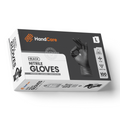Are you looking for single-use hand protection for personal or professional purposes? If so, then nitrile protective gloves would be your best choice.
Why? Nitrile gloves are better than latex, vinyl, and other similar materials because they offer better protection, more comfort, and less allergy risk. Unlike latex, nitrile does not contain natural rubber proteins that may cause latex allergies and allergic reactions. And the material is stronger and stretchier than most of its competitors.
Nitrile disposable gloves come with several other benefits that make them the best choice overall. Here are the 9 top reasons why nitrile gloves are better than latex and vinyl.
At a glance:
- 9 Reasons Why Nitriles Gloves are Better:
- Superior Chemical Resistance
- Best Tear and Puncture Resistance
- 100% Latex-Free
- High Tactile Sensitivity
- Proper and Comfortable Fit
- Lower Friction Resistance
- Wide-Range of Applications
- Completely Waterproof
- Long-Lasting Use
- How Were Nitrile Gloves Developed?
- How You Can Use Nitrile Gloves
- Related Questions
- Nitrile Gloves Offer Superior Protection Over Latex and Vinyl
1. Nitrile Has Superior Chemical Resistance Compared to Latex and Vinyl
Vinyl and Latex are known to have little chemical resistance, which makes them a poor choice when working in labs, hospitals, or even when using household cleaners. On the other hand, nitrile has superior chemical resistance and is widely used in industries where hand protection is essential. This includes medical and scientific labs, manufacturing, chemical production facilities, oil and gas-related sectors, and other high-risk workplaces.
In these environments, it's not enough to just wash your hands. Take a closer look at why with our post on hand washing vs glove use. So, when it comes down to nitrile vs latex and vinyl, it’s clear that nitrile gloves protect your hands from corrosive chemicals that vinyl and latex can’t stand up to. Plus, nitrile protective gloves have a puncture resistant design that can further protect hands from hazardous chemicals.
2. Disposable Protective Gloves with the Best Tear and Puncture Resistance
Which protective hand covering offers the best tear and puncture resistance? The clear answer is gloves made of nitrile. Nitrile is 3 to 4 times more puncture resistant compared to latex. This makes it a suitable material for those seeking durable mechanical hand protection, or for anyone requiring protection in risky workplaces, especially where sharp objects are used.
In addition, these medical and utility grade gloves are capable of protecting your hands from cuts, wounds, scratches, bruises, etc. Furthermore, when researching nitrile vs latex, you will find that puncture holes are hard to detect in latex, putting the user at risk of being exposed to hazardous materials. This is not the case with nitrile gloves, making them the wise choice for reliable hand protection, especially for those working with environmental contaminants or bloodborne pathogens.

3. Industry or Home - Use Gloves that are 100% Latex-Free
Nitrile gloves are better than latex when it comes to avoiding allergic reactions while wearing them. Latex contains natural rubber proteins that can cause an allergic reaction when worn, and nitrile does not. In addition to this, even those individuals who are not known to be allergic to latex can, over time, develop an allergy to latex with repeated use – not a good scenario for those working within industries that require disposable protective glove use.
Latex-free nitrile gloves are also useful in emergency healthcare settings when a patient’s latex allergy status is unknown. The same goes for tattoo artists, beauticians, or anyone else who has to make physical contact with clients.
4. Nitrile Gloves Offer High Tactile Sensitivity
Nitrile is a superior material that allows the user to retain their sense of touch. This means it enables the glove user to feel and manipulate objects easily in their hands. In contrast, other materials may limit your scope of handling objects, as well as reduce the sense of touch. This can be troublesome in certain industries. However, nitrile eliminates this problem by providing high tactile sensitivity. In sum, single-use gloves made of nitrile are designed to be used when protection is needed, and sensitivity and dexterity are required as well.

5. Protective Gloves that Provide a Proper and Comfortable Fit
While disposable gloves are mostly designed to provide protection, they should also offer comfort and the ability to fit properly. This is especially true in industries where the hands are covered for a good portion of the day – medical fields, mechanic shops, food industry, production lines, and more. Nitrile gloves offer the comfort and fit that industry professionals, as well as home users need. They allow for a perfect fit and match the shape of the hand. In addition to this, they have the ability to react to your physical temperature which causes them to conform for a natural, snug, and comfortable fit.
6. Lower Friction Resistance Perfect for Frequent Glove Changing
Nitrile is a low friction material, which makes them especially easy to put on and take off. This is an essential feature when constant changing is required. A few examples might include a dentist’s office, a medical lab where blood is drawn, and the like.
If you are a nurse in the medical field, the following article we put together was created just for you, and worth reading - What Type of Disposable Gloves Should Nurses Wear? Additionally, nitrile gloves are better than common disposable hand protection because they don’t require the allergy-causing powder for ease of wear.

7. Nitrile Gloves Offer a Wide-Range of Applications
Thanks to the high-quality properties of these superior gloves, they are a choice material for several industries that require hand protection. They are commonly used in the following sectors:
- Food Industry (restaurants, catering, food processing facilities)
- Healthcare (hospitals, medical labs, nursing homes)
- Automotive Industry (mechanics, production lines)
- Chemical Facilities (production, manufacturing)
- Cleaning Industry (home, commercial)
This is just a shortlist of industries, but as you can imagine, they can be used for just about any situation where hand protection is needed.

8. Gloves Made of Nitrile are Completely Waterproof
If you work in an industry where keeping your hands dry is important, then hand covering made of nitrile can meet your needs because they are entirely waterproof. You can wear them alone or wear them under your usual working gloves to prevent water permeation. They are suitable for damp workplaces and do a great job at keeping your hands dry.
Disposable nitrile gloves are greaseproof, too. This is one reason they’re popular with auto mechanics and food service workers.
9. Nitrile Gloves are Better than Latex for Long-Lasting Use
If you need durable, long-lasting disposable hand protection, it’s clear that nitrile gloves will serve you longer than latex will. Nitrile is an incredibly strong and durable material that’s used in manufacturing top-shelf gloves. They have a long shelf life before use, and while being used, they provide the necessary strength, flexibility, and durability to finish tasks while protecting the hands from contaminated or corrosive materials for an extended period of time. Plus, they are three times more puncture resistant compared to latex – making them better than latex when it comes to long-lasting use.

How Were Nitrile Gloves Developed?
Disposable nitrile gloves were developed in the ‘80s by Neil Tillitson and Luc DeBecker. Made out of acrylonitrile and butadiene monomers, nitrile gloves were found to have many benefits over their latex competitors - for starters, nitrile is more chemical resistant than latex.
Nitrile gloves hit the scene in a big way in the ‘90s. They quickly became popular because latex allergies were proving to be quite common at the time. This made people want to find an alternative to latex gloves.
Although latex allergies are quite rare nowadays, with less than one percent of people in the United States having a latex allergy, some people are at a higher risk of having allergic reactions. These include healthcare workers. Between eight and 17 percent of healthcare workers are allergic to latex.
Interestingly, while latex allergies seemed to be more common during the ‘80s and ‘90s, these days they are less common because of how people have been using latex alternatives, such as nitrile.
How You Can Use Nitrile Gloves
Here’s a rundown of some common nitrile glove uses.
- Cleaning the home. Sometimes you’ll need to clean and disinfect your home with the use of harsh chemicals. You don’t want them to come into contact with your skin, and wearing nitrile cleaning gloves will prevent that since they’re very resistant to chemicals. They also won’t degrade after coming into contact with such substances. In addition, you can engage in potentially dangerous tasks, such as picking up broken glass, in a safer way by wearing nitrile gloves because they’re such a protective barrier for your skin.
- If you love gardening, you’ll come into contact with a variety of things, such as soil and bacteria in the soil, fertilizer, and other chemicals. Nitrile gloves will be able to protect your skin against these offenders. In addition, since nitrile gloves are resistant to punctures, you will be able to prevent injuries, whether from thorns or your gardening tools.
- Protecting your hands from cooking dangers, such as cutting or burning yourself, will be an easy task for nitrile gloves that are resistant to tearing and breaking. However, wearing gloves while you cook will also help to prevent bacteria from spreading.
- Disposable nitrile gloves are great for COVID-19 protection. You might want to wear nitrile gloves when coming into contact with people and items that could be contaminated. Nitrile gloves are a solid choice because of how strong and durable they are. However, it’s important not to rely on wearing gloves alone to protect you as simple mistakes when wearing them can put you at risk of being contaminated.
Related Questions
What are some drawbacks of nitrile gloves?
Nitrile gloves can lack some tactile grip when compared to latex gloves.
But, you can work around this. Make sure you choose nitrile gloves that have 3-mil thickness as well as textured fingertips.
Can you find nitrile gloves with greater cuff length?
You can find nitrile gloves that protect your hands and wrists much more effectively.
An example is Ammex Gloveworks HD nitrile gloves that offer 9.5 inches of material from your fingertips to glove cuffs, so you’ll feel more protected against harsh chemicals.
Does the color of nitrile gloves matter?
You’ve probably seen that nitrile gloves come in a variety of colors, such as white, blue, orange, and black.
Different nitrile glove colors serve various benefits. For starters, brightly colored gloves can stand out against your skin, making it easier to spot any punctures or tears. In addition, some colors make it easier to hide stains produced by various substances.
Examples can be seen when working with grease, such as in the case of mechanics, or when working with ink, such as in the case of tattoo artists. Black gloves hide ink stains well. Blue gloves may help make bloodstains look less dramatic, making them great for healthcare workers.
Nitrile Gloves Offer Superior Protection Over Latex and Vinyl
Choosing the right glove for your needs is important, especially when protection is needed. It’s been proven that nitrile is a stronger and better quality material than Latex or vinyl, and is the preferred choice of many industry professionals, as well as home users. Nitrile gloves are frequently used by police officers, housekeepers, security guards, veterinarians, factory workers, emergency, healthcare professionals, and others.
All in all, nitrile offers you that extra protection needed to give you peace of mind. For those who would like to dive even deeper into this topic, view our article Nitrile vs Latex Gloves - A Comprehensive Comparison.







